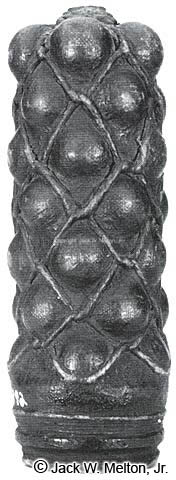Pre-war Federal
Quilted grape
DIAMETER: 2.74 inches
GUN: 3-pounder smoothbore, 2.9-inch caliber
LENGTH: 8 inches
WEIGHT: 8 pounds 12 ounces
CONSTRUCTION: Quilted grape
SABOT: Wooden cylinder
FUZING: None

Pre-war Federal
DIAMETER: 2.74 inches |
 |
|||
| This is an example of a pre-war grape shot projectile. It consisted of a wooden base with a rod centered like a bolt around which lead balls were piled in tiers. The above arrangement was then completely enclosed in canvas, and a heavy twine (sometimes wire) was stitched between the balls. This gave the projectile its distinctive quilted-like appearance and common name quilted grape. The book known as Cooper's Tactics, 1845 Edition, stated that the Federal forces continued the use of the 3-pounder smoothbore cannon into the 1820's as a light field artillery piece. According to Louis De Tousard's American Artillerist's Companion, 1809 Edition; and Duane's Military Dictionary, 1810 Edition; they considered, based on their tests, that the 3- and 4-pounder quilted grape shot was accurate and dependable at 400-500 yards. Less than 400 yards case-shot and canister were more effective, primarily, because of the dispersement. The early manufactured quilted grape contained lead balls. The lead balls deformed to much upon the ignition of the powder charge. Lead balls were later replace with iron. This example contains thirty-five one-inch lead balls and is located in the West Point Military Academy Museum. | ||||